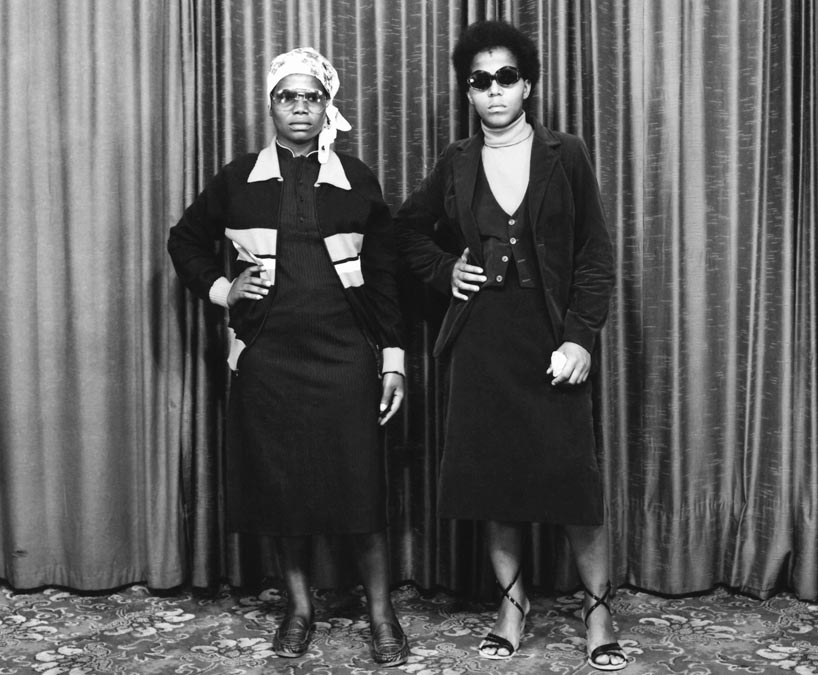The female gaze

S. J. Moodley, [Two women wearing Western attire], 1981 (printed 2016), inkjet print. Courtesy of The Walther Collection.
This fall, the Ryerson Image Centre (RIC) will present a major exhibition exploring African photographic portraiture through the perspectives of women, both as sitters and photographers. Guest curated by rising scholar Sandrine Colard and organized by the RIC in collaboration with The Walther Collection, The Way She Looks: A History of Female Gazes in African Portraiture (external link) features contemporary works by female artists alongside 20th century studio portraits and early colonial images and albums. The exhibition opens on September 11 and runs until December 8.
Throughout the history of photography, African women’s bodies have been repeatedly objectified and fetishized. The Way She Looks shifts the focus instead towards women’s gazes and highlights female acts of looking that challenge the male-dominated narrative of the medium. Showcasing over 100 works by both female and male practitioners from across Africa, the exhibition emphasizes the ways women see and present themselves while tracing how they moved from being eloquent photographic subjects to adopting positions behind the camera.
“Because the history of photography in Africa has concentrated on a few famous male photographers, the role of women in photography has often been overlooked,” says Colard, a specialist of modern and contemporary African art. “By focusing on female portraiture and photographers, the goal of the exhibition is to account for their viewpoints in that history.”
Colard is an art historian, writer and curator based in New York and Brussels. She is a professor at Rutgers University-Newark and has been appointed Artistic Director of the 6th Lubumbashi Biennale 2019, Democratic Republic of Congo (DRC).
The works on view will be drawn entirely from The Walther Collection, one of the world’s most important holdings of photography and lens-based art from Africa. The Way She Looks represents the first time photographs from this significant collection have been exhibited in Canada.
The exhibition is divided chronologically into three parts. The first section showcases 19th and early 20th-century photographic prints, cartes de visite, postcards, albums, and books from Southern and Eastern Africa. Despite the unequal power dynamics of colonial imagery, many early photographs offer windows into their subjects’ experiences; the exhibition foregrounds photographs from this era in which the female sitters’ confident and forthright gazes rival that of the photographer.
The second section features women’s portraits since the 1950s by notable West African photographers, such as Malick Sidibé and Seydou Keïta. As regular patrons of rapidly emerging portrait studios, women increasingly became co-authors of their own image: they styled themselves, carefully chose their outfits, commissioned the photographer, and performed during studio sessions. At the same time, documentary photographers began to record the African female experience in a period of rapid social, cultural and political change as many nations prepared for and achieved independence.
The final section highlights a number of significant African female and non-binary artists who have emerged since the 1990s, including Yto Barrada, Jodi Bieber, Zanele Muholi (documentary media ’10), Lebohang Kganye, Grace Ndiritu, Nontsikelolo “Lolo” Veleko, Sue Williamson and Mimi Cherono Ng’ok. Exploring a wide array of subjects, from feminist, queer, and gender issues to history, kinship, migration, memory, and loss, many of the works made by these artists challenge conventional understandings of African female photographic representation.
“By privileging women’s perspectives, both in front of and behind the camera, this groundbreaking exhibition confronts the canons of art history and allows for new narratives,” says RIC exhibitions curator Gaëlle Morel. “We’re thrilled to celebrate the work of so many leading African artists, many of whom are being shown in Canada for the first time.”
In addition to The Way She Looks, two more exhibitions will also open on September 11:
Syrus Marcus Ware: Ancestors, Can You Read Us? (Dispatches From The Future) (external link)
Toronto-based artist Syrus Marcus Ware imagines a world where racialized people have survived the “Black death spectacle” writ large on the nightly news; survived the catastrophic impact of the Anthropocene; and survived the crushing effects of white supremacy. Commissioned by the Toronto Biennial of Art and the RIC, the artist draws on the shared language of speculative fiction and political activism to transform the Salah J. Bachir New Media Wall into a portal through which the next generation of racialized activists communicate with us, their ancestors, and offer us insights into the future.
Da Pi Yuan (external link)
In Da Pi Yuan, artist Lucy Lu explores the complexities of growing up with a mixed identity. Returning to her childhood home in Xi’an, China, to the gated apartment community where her grandparents still live, Lu documents the places and people that have remained vivid in her memories in order to understand what it means to be Chinese-Canadian. Through images and words, Da Pi Yuan examines notions of home, belonging and the fragmented nature of memory.
A full schedule of free public programming, including tours and talks, is available at ryersonimagecentre.ca/events (external link) .